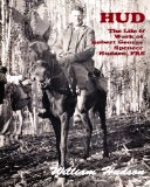‘Hud’ - The Life and Work of Robert George Spencer Hudson, FRS

William Hudson
Published by: San Antonio, Texas
Publication date: 2008
ISBN-10: 0981555624
List price: $15 plus p&p (Amazon)
117 pp
The cover to this biography features an arresting scene in the wooded foothills of somewhere mountainous, probably Kurdistan − a robed left hand holds the bridle of a magnificent mule, ears alert, on whose saddle sits the substantial figure of Robert George Spencer Hudson of the Iraq Petroleum Company (IPC). Hudson is sitting back and stares imperiously at the camera, brown hair tousled with eyes slightly hooded against the sun. From his saddlebag the wooden shaft of a geological hammer sticks out: one imagines the bags to be stuffed with samples and fossils collected so far that day. In the left lapel and top buttonhole of his tweed jacket are entwined thongs leading to chest and side pockets, evidently attached to hand lens and compass-clinometer. The date of the photograph is 1947, yet just seven years earlier, Hudson, a devoted academic, had abruptly resigned his newly - and hard - won Chair of Geology at the University of Leeds. How did this remarkable transition, from Yorkshire to Kurdistan, come about?
The story is told by Hudson’s son, William, himself also a geologist. RGS Hudson was born in 1895, his father a skilled carpenter. We learn of his education up to the age of 20 as an external University of London Science graduate, and war service until (at the battle of Bullecourt in 1917, serving as a young 2nd Lieutenant of the Warwickshire Regiment) he was shot through the neck, the scar of the exit wound clearly visible on his chin in the photograph described above. He then studied geology at UCL under EJ Garwood gaining BSc First Class Honours, an MSc by research in 1922, an assistant lectureship at the University of Leeds in 1922 and a DSc on the basis of his original published research in 1929. His thesis was the first detailed elucidation of the stratigraphy and palaeontology of the Carboniferous Yoredale cyclothems of Upper Wensleydale. In the next 20 years he and his students did intensive fieldwork, publishing a string of pioneering papers on the Carboniferous structure, stratigraphy and palaeontology of the Craven basin and Askrigg block, the latter which he named. Hudson was even co-founder of the British Speleological Association.
Hudson resigned abruptly from his Chair at Leeds when, after representations from various factions, aspects of his personal life were deemed unacceptable by the Vice-Chancellor. But all was not lost! He moved on to undertake pioneering palaeontological and stratigraphic research all over the Middle East - Iraq, Kurdistan, Palestine, Oman, Emirates. Following the 1958 Iraqi revolt and the nationalisation of the IPC, Hudson returned to academia and eventually secured the Chair at Trinity College, Dublin. His last 10 years were glory years: Vice-President and Murchison medallist of the Geological Society, Fellow of the Royal Society and eminence grise behind the founding of the Palaeontological Association. He died in Dublin in 1965, his new devotion to Irish Carboniferous geology and his reform of the Trinity department left tragically incomplete.
William Hudson’s handsome, well illustrated and sensitively told book deserves a wide audience. It should appeal to Carboniferous aficionados, geologists in Yorkshire, Ireland and the Middle East, historians of scientific progress, and those social historians of past misdeeds of autocrats in great Universities. In present halcyon days of ´working locally, thinking globally´ it is reassuring to know that we stand on the broad shoulders of grafting giants like ´Hud´.
Mike Leeder